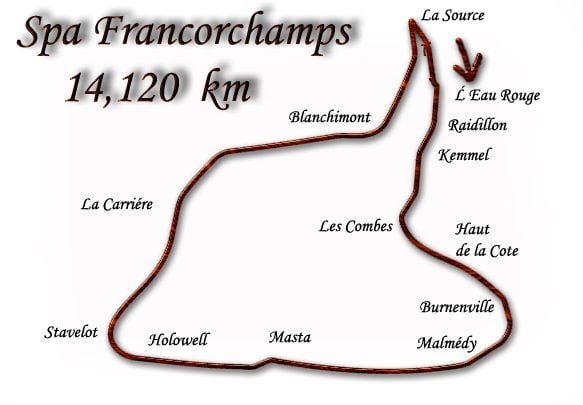- 14,660

- The UK
- JASON_ROCKS1998
- JR98 GAMING


The Spa Francorchamps circuit was first constructed in 1920, using public roads between Francorchamps, Malmedy and Stavelot. The classic circuit was a speed course with drivers managing higher average speeds than other race tracks. Spa was the fastest race track in Europe at the time, with a nasty reputation for being fast and dangerous, a circuit known to be one for the brave and most drivers were frightened of it.
The old Spa circuit was unique in that speeds were consistently high with hardly any let-up at all for 3–4 minutes. This made it an extraordinarily difficult mental challenge, because most of the corners were taken at 180+ mph and were not quite flat- every corner was as important as the one before it. If a driver lifted just that little bit more, then whole seconds, not tenths- would be lost. Even the slightest error of any kind was punished very harshly in more ways than one. But this reality also worked inversely- huge advantages could be gained if a driver came out of a corner slightly faster.
Spa became notorious for fatal accidents, as there were many deaths each year at the ultra-fast track, especially at the 1960 Belgian Grand Prix where 2 drivers, Chris Barstow and Alan Stacey were both killed within 15 minutes (although Stacey's accident was caused by a bird hitting him in the face) and Stirling Moss had crashed at Burnenville during practice and was severely injured. When Armco crash barriers were added to the track in 1970, deaths became less frequent there but the track was still notorious for other factors.
In 1969, the Belgian Grand Prix was boycotted by F1 because of the extreme danger of Spa. There had been 10 racing fatalities in total at the track in the 1960s, including 5 in the 2 years previous. The drivers demanded changes made to Spa which were not possible on short notice, so the Belgian Grand Prix was dropped that year. Armco was added to the track and sections of it were improved (especially the Stavelot and Holowell sections), just like Armco had been added for the 1969 Le Mans race.
One last race there the following year on the improved track was still not satisfactory enough (even after a temporary chicane was added at Malmedy just for that race) for the drivers in terms of safety, and even with the chicane, the drivers averaged 150+ mph (240 km/h) during the race. For the 1971 race, the track owners and authorities had not brought the track up to date with mandatory safety measures, and the race was cancelled. Formula One would not return to Spa until 1983 on the modern track.

